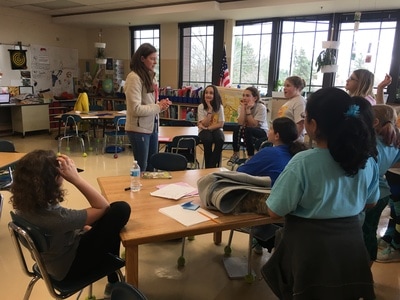Krissa Skogen, Ph.D.
Understanding the diversity of life starts with uncovering the evolutionary histories and relationships between interacting organisms and landscapes. As a botanist, I am fascinated by the rich diversity of flowering plants (angiosperms) and the insects that interact with them - both pollinators and antagonists (herbivores, seed predators, etc.) - and how these interactions may help explain the great diversity we see today. Much of my work focuses on differences between hawkmoth- and bee-pollinated plant species and the implications for floral phenotypes (shape, color, size, scent), population connectivity, and species boundaries. I'm also fascinated by the role that antagonists may play, especially those that are attracted to the same floral cues that attract pollinators (including color and scent) given the opposing, negative impacts of floral antagonists on plant fitness. Much of this work uses the Geographic Mosaic Theory of Coevolution as a model to explain the evolutionary relationships between members of the evening primrose family, Onagraceae, their hawkmoth and bee pollinators, and antagonist microlepidoptera in the genus Mompha (more info here).
I am also committed to plant conservation efforts, including investigating the impacts of anthropogenic factors on plants and pollinators. New funding from the Fish and Wildlife Foundation and the Bureau of Land Management will explore the impact of oil and gas development on the rare Amsonia tharpii (Apocynaceae) which will inform decisions on its listing on the Endangered Species Act as well as management and conservation decisions to conserve extant populations.
My previous work has investigated the impact of land use change on an endemic, hawkmoth-pollinated evening primrose, Oenothera harringtonii and the role that atmospheric nitrogen deposition may have played in the decline of the nitrogen-fixing legume, Desmodium cuspidatum.
Understanding the diversity of life starts with uncovering the evolutionary histories and relationships between interacting organisms and landscapes. As a botanist, I am fascinated by the rich diversity of flowering plants (angiosperms) and the insects that interact with them - both pollinators and antagonists (herbivores, seed predators, etc.) - and how these interactions may help explain the great diversity we see today. Much of my work focuses on differences between hawkmoth- and bee-pollinated plant species and the implications for floral phenotypes (shape, color, size, scent), population connectivity, and species boundaries. I'm also fascinated by the role that antagonists may play, especially those that are attracted to the same floral cues that attract pollinators (including color and scent) given the opposing, negative impacts of floral antagonists on plant fitness. Much of this work uses the Geographic Mosaic Theory of Coevolution as a model to explain the evolutionary relationships between members of the evening primrose family, Onagraceae, their hawkmoth and bee pollinators, and antagonist microlepidoptera in the genus Mompha (more info here).
I am also committed to plant conservation efforts, including investigating the impacts of anthropogenic factors on plants and pollinators. New funding from the Fish and Wildlife Foundation and the Bureau of Land Management will explore the impact of oil and gas development on the rare Amsonia tharpii (Apocynaceae) which will inform decisions on its listing on the Endangered Species Act as well as management and conservation decisions to conserve extant populations.
My previous work has investigated the impact of land use change on an endemic, hawkmoth-pollinated evening primrose, Oenothera harringtonii and the role that atmospheric nitrogen deposition may have played in the decline of the nitrogen-fixing legume, Desmodium cuspidatum.
Lab News
Congrats to Zoe Diaz-Martin and Anita Cisternas-Fuentez who lead the work published in Heredity - Shifts in reproductive strategies and their consequences for divergence, gene flow , and genetic diversity!
Check out Kelly Mikenas' new paper in Urban Ecosystems - Native plant communities provide enhanced stormwater capture and evapotranspiration compared to Sedum on green roofs
Bing Li's Master's work is now out in International Journal of Plant Sciences - Genetic and floral trait changes in Oenothera organensis (Onagraceae) during long-term ex situ cultivation!
Emily Lewis' Master's work is part of the American Journal of Botany special issue, "Pollen as the link between phenotype and fitness"! Hawkmoth and bee pollinators impact pollen dispersal at the landscape but not the local scales in two species of Oenothera.
Listen to the piece from Marfa Public Radio's Nature Notes series to learn about the work that Krissa, Jeremie Fant, colleagues and students have done in the western US! The evening primrose is the center of an aromatic drama in the desert night
Check out Kelly Mikenas' new paper in Urban Ecosystems - Native plant communities provide enhanced stormwater capture and evapotranspiration compared to Sedum on green roofs
Bing Li's Master's work is now out in International Journal of Plant Sciences - Genetic and floral trait changes in Oenothera organensis (Onagraceae) during long-term ex situ cultivation!
Emily Lewis' Master's work is part of the American Journal of Botany special issue, "Pollen as the link between phenotype and fitness"! Hawkmoth and bee pollinators impact pollen dispersal at the landscape but not the local scales in two species of Oenothera.
Listen to the piece from Marfa Public Radio's Nature Notes series to learn about the work that Krissa, Jeremie Fant, colleagues and students have done in the western US! The evening primrose is the center of an aromatic drama in the desert night
Engagement & Media Updates!
Learn about Krissa's experiences with Homeward Bound as
one of 100 women in STEMM to travel together to Antarctica!
CBG Blog Post
Better Magazine
Indy Star Newspaper Article
Glencoe Anchor Newspaper Article
Energy News Network
one of 100 women in STEMM to travel together to Antarctica!
CBG Blog Post
Better Magazine
Indy Star Newspaper Article
Glencoe Anchor Newspaper Article
Energy News Network



